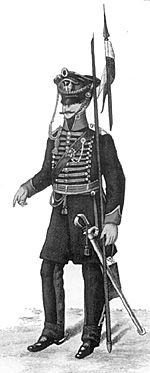 I was surprised to read that Christopher Sweet found no
more than a brief mention of the Prussian 'National Cavalry
Regiments' in my Ospreys. On checking them, I found this
indeed to be the case. I thought I had covered these four
regiments in more detail, but as I did not, I hope this article
goes some way to making amends.
I was surprised to read that Christopher Sweet found no
more than a brief mention of the Prussian 'National Cavalry
Regiments' in my Ospreys. On checking them, I found this
indeed to be the case. I thought I had covered these four
regiments in more detail, but as I did not, I hope this article
goes some way to making amends.
The East Prussian National Cavalry Regiment
The regiment was the first of the 'National Cavalry Regiments'. It was founded as part of the troops raised by General von Yorck in East Prussia at the beginning of 1813 to support his rebellion. Its members were to be volunteers and were required to bring their own saddle and riding equipment. Recruitment was restricted to East and West Prussia and Lithuania. Once Prussia declared itself against Napoleon, the King chose the regiment's officers. East Prussian National Cavalry
The strength of the regiment was set at 1,000 men with 25 elites per squadron. During the summer of 1813, the elites were used to form a volunteer detachment. The uniform consisted of a blue Lithewka coat with yellow hussar cords, red collars and cuffs, white shoulder straps, grey riding overalls with broad red stripes. The volunteers wore green shoulder straps. Headwear was a kiwer. The first rank carried lances, the remainder were armed with sabres and pistols.
It fought as part of I Army Corps in autumn 1813.
 Pomerania and Silesia
Pomerania and Silesia
In March 1813, the estates of Pomerania and Silesia were also ordered to set about raising a 'National Cavalry Regiment' each. The Pomeranians raised three squadrons, each with an Elite troop. They wore green coatees with white facings and yellow buttons. It was known as the 'Pomeranian Light National Cavalry Regiment'. It fought as part of the III Army Corps in 1813.
Silesian and East Prussian National Cavalry
The Silesians, under the guidance of Graf Henckel von Donnersmarck, had already started. They chose a hussar uniform consisting of blacks dolmans and pelisses with red cords and yellow buttons, red collars and cuffs. Headwear was a shako and grey riding overalls were worn. Armament consisted of a sabre, carbine and pistols. Two squadrons were raised, later joined by a green-clad detachment of volunteers, 50 men strong. It was known as the 'Silesian National Hussar Regiment'. It fought as part of the II Army Corps in 1813.
The Elbe National Hussar Regiment
Once the part of Germany between the Elbe and Weser rivers had been liberated, a further 'National Cavalry Regiment' was raised. Four squadrons strong, it was clothed in green dolmans and pelisses with yellow cords and blue collars. The pelisses had white fur for officers, fox red for NCOs, black for troopers. Headwear consisted of black felt shakos. Sabres and pistols were carried.
Reorganisation in 1815
War started in 1815 with the Prussian army in the throes of a reorganisation. One squadron of the Elbe National Hussars had been used to form the 8th Dragoon Regiment, three formed the 10th Hussars. Two of the Silesians were incorporated in the 7th Hussars, and one each of the Pomeranians and East Prussians in the 4th Uhlans. Of these, the 8th Dragoons and 10th Hussars saw action in 1815, both as part of the IV Army Corps.
More Notes and Queries
Back to Table of Contents -- Age of Napoleon #31
Back to Age of Napoleon List of Issues
Back to MagWeb Master Magazine List
© Copyright 1999 by Partizan Press.
This article appears in MagWeb (Magazine Web) on the Internet World Wide Web. Other military history articles and gaming articles are available at http://www.magweb.com